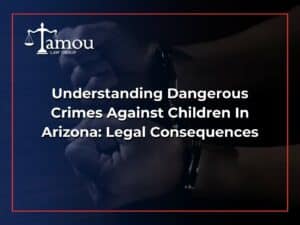Understanding Criminal Damage in Arizona: The Statute Explained
In Arizona, criminal damage is a serious offense with far-reaching legal consequences. Whether it’s defacing property, tampering with utility equipment, or damaging someone’s vehicle, criminal damage laws under Arizona Revised Statute (ARS) 13-1602—commonly referred to as ARS Criminal Damage—cover a wide range of actions. The penalties for such crimes can vary significantly depending on the circumstances, including the value of the property damaged and whether the damage involves public utilities or private property.
This blog aims to provide a thorough explanation of ARS Criminal Damage, outlining the various forms of criminal damage, potential defenses, penalties, and how such cases are prosecuted in Arizona. If you’re facing criminal damage charges or want to learn more about the law, this comprehensive guide is designed to help.
What Is ARS Criminal Damage?
According to ARS Criminal Damage (ARS 13-1602) laws, the act involves recklessly damaging, defacing, or tampering with someone else’s property. “Recklessly” is a key element in most criminal damage cases in Arizona. This means the offender acted with a conscious disregard of a substantial risk that their actions would cause damage or harm. Arizona law takes into account both reckless behavior and intentional actions, with different penalties based on the level of intent and damage.
Under ARS Criminal Damage, criminal damage can occur in several ways. The statute breaks down the offense into specific types:
- Recklessly defacing or damaging the property of another person.
- Recklessly tampering with property belonging to someone else in a way that substantially impairs its function or value.
- Recklessly damaging property belonging to a utility.
- Recklessly parking a vehicle in such a way that it deprives livestock of access to the only reasonably available water.
- Recklessly inscribing, drawing, or writing a message, slogan, sign, or symbol on any public or private building, structure, or surface without the owner’s permission (commonly known as graffiti).
- Intentionally tampering with utility property.
To better understand these categories, let’s break down each provision and explore examples of criminal damage in Arizona.

Types of Criminal Damage Defined in ARS Criminal Damage
1. Defacing or Damaging Another Person’s Property
This is one of the most common forms of criminal damage. Examples include actions such as spray-painting someone else’s fence, keying a car, or smashing windows. Whether the damage is done recklessly or intentionally, the person responsible can face criminal damage charges under ARS Criminal Damage.
For instance, if someone gets into a fight and, during the altercation, knocks over a table that breaks a window, they could be charged with criminal damage. Even if the primary intent wasn’t to damage the window, the reckless behavior leads to criminal liability. If the fight involves a loved one, it could have more severe punishments if classified as a Domestic Violence Offense.
2. Tampering with Property to Impair Its Function or Value
Tampering with property in a way that impairs its function or reduces its value is another form of criminal damage. For example, cutting the wires to someone’s surveillance camera or disabling a car engine by messing with its internal components would qualify as tampering. This type of criminal damage can have significant financial implications, especially when it results in costly repairs or loss of functionality.
3. Damaging Utility Property
Utility services like electricity, water, and gas are critical to public safety and daily life. Damaging utility property is treated as a serious offense under ARS Criminal Damage, especially if the damage leads to a disruption in service. Cutting power lines, tampering with water mains, or vandalizing utility boxes could all lead to criminal charges.
4. Blocking Livestock Access to Water
While less common, this type of criminal damage involves recklessly parking a vehicle in a manner that deprives livestock of access to water. In rural areas, this could be a significant offense, as it can directly impact the health and well-being of animals. Arizona has a large agricultural sector, and offenses like this are taken seriously.
5. Graffiti and Defacing Property
Graffiti may seem like a minor offense, but under ARS Criminal Damage, it is a serious crime if it is done without permission. Graffiti can include spray-painting slogans, symbols, or signs on public or private property. Even if the graffiti is artistic, if done without the owner’s consent, it is considered criminal damage. The penalties for graffiti can range from fines to jail time, depending on the extent of the damage.
6. Tampering with Utility Property
Unlike the other types of criminal damage, this provision under ARS Criminal Damage refers to the intentional tampering with utility property. Intentional tampering could include interfering with electrical grids, water supplies, or other utility systems that are essential to public safety. Arizona law treats this form of criminal damage particularly harshly due to the potential danger and public inconvenience it can cause.

Recklessness and Intent in ARS Criminal Damage
A significant factor in most ARS Criminal Damage cases is whether the defendant acted “recklessly.” Arizona law defines recklessness as the conscious disregard of a known risk that actions will result in damage or harm. This makes it possible to face criminal charges even if the damage wasn’t intentional.
For example, if someone is intoxicated and damages property during a fight, their reckless actions can result in criminal damage charges. Similarly, if someone engages in risky behavior that unintentionally damages property, they could be found guilty of acting recklessly.
In contrast, intentional acts of criminal damage are usually associated with more severe penalties, particularly when the intent was to cause harm, such as vandalizing utility equipment or defacing public property. Both recklessness and intent play key roles in determining the severity of the charges and penalties under ARS Criminal Damage.
Penalties for ARS Criminal Damage
The penalties for criminal damage under ARS 13-1602 depend on the monetary value of the damage and the type of property involved. In general, the penalties range from misdemeanors to serious felonies, with consequences including jail time, fines, and restitution to the victim.
Class 4 Felony Criminal Damage
If the property damage is valued at $10,000 or more, or if the damage involves utility property valued at $5,000 or more, or if tampering with utilities creates a public safety hazard, the offense is classified as a Class 4 felony. Penalties for a Class 4 felony include a prison sentence ranging from one to 3.75 years for a first-time offender.
Class 5 Felony Criminal Damage
When the value of the property damage falls between $2,000 and $10,000, or if the damage was linked to gang or organized crime activities, the offense is considered a Class 5 felony. Penalties include six months to 2.5 years in prison for a first-time offense.
Class 6 Felony Criminal Damage
If the property damage is valued between $1,000 and $2,000, the crime is classified as a Class 6 felony. While this is the least severe felony under ARS Criminal Damage, it still carries the possibility of prison time, ranging from four months to two years.
Class 1 Misdemeanor Criminal Damage
When the value of the damaged property is between $250 and $1,000, criminal damage is classified as a Class 1 misdemeanor. A Class 1 misdemeanor can result in up to six months in jail, along with fines and restitution.
Class 2 Misdemeanor Criminal Damage
Any criminal damage involving property valued at less than $250 is classified as a Class 2 misdemeanor. Penalties for this charge include up to four months in jail, fines, and restitution.
Determining Property Damage Value in ARS Criminal Damage
The value of the property damage is crucial in determining the severity of the criminal damage charge under ARS 13-1602. Courts consider several factors when calculating the monetary value of the damage, including:
- Labor costs for repairing or replacing the damaged property.
- Material costs for repairs.
- Equipment costs for specialized tools or machinery used in repairs.
These costs are often established through expert testimony, appraisals, or estimates from professionals. The total amount is then used to determine whether the offense is classified as a misdemeanor or a felony, as well as the appropriate level of punishment.
How to Beat ARS Criminal Damage Charges in Arizona
Facing criminal damage charges can be daunting, but there are several defense strategies that a skilled attorney can use to challenge the prosecution’s case. Below are some of the common defenses to ARS Criminal Damage charges:
1. Lack of Intent or Recklessness
A key element of most ARS Criminal Damage charges is proving that the defendant acted recklessly or intentionally. If your attorney can show that the damage was purely accidental or that you lacked the requisite reckless mindset, the charges may be reduced or dismissed. For instance, if you were unaware of the risk your actions posed and had no intent to cause harm, it may be argued that you did not act recklessly.
2. Mistaken Identity
In some cases, particularly involving graffiti or public vandalism, mistaken identity can be a legitimate defense. If the prosecution cannot prove that you were the individual responsible for the damage, your charges may not hold. Video surveillance, witness statements, or forensic evidence can be used to dispute the claim that you committed the criminal damage.
3. Property Ownership Disputes
If there’s confusion over who owns the damaged property, it could weaken the prosecution’s case. For example, if you believed that you had permission to modify or alter the property, or if there was a legitimate ownership dispute, this could serve as a defense against ARS Criminal Damage charges.
4. Challenging the Valuation of the Damage
Since ARS Criminal Damage penalties are closely tied to the monetary value of the property damage, disputing the estimated cost can be a powerful defense. If the prosecution overestimates the value of the damage, your attorney can bring in expert witnesses to challenge the accuracy of the valuation, potentially reducing the charges from a felony to a misdemeanor.
Conclusion
ARS Criminal Damage covers a wide range of property crimes in Arizona, from minor vandalism to significant destruction of utility services. The law distinguishes between reckless and intentional acts, with penalties ranging from minor fines to years of imprisonment. Understanding the full scope of ARS Criminal Damage and its associated penalties is crucial if you’re facing charges or involved in a case where criminal damage is alleged.
If you or someone you know is facing charges under ARS Criminal Damage, it’s essential to seek legal advice immediately. With the help of Tamou Law Group you can build a strong defense, challenge the prosecution’s evidence, and work towards the best possible outcome in your case. Call us now at 623-321-4699 for a free consultation!

Tamou Law Group
Scottsdale Office
9375 E Shea Blvd #100
Scottsdale, AZ 85260
Phone: 623-321-4699



![The Top 3 Probation Violation Lawyers in Phoenix, AZ [2025]](https://tamoulawgroup.com/wp-content/uploads/2025/11/phoenix-probation-violation-lawyer-300x300.png)
![How to Beat a DUI Charge in Phoenix, AZ [2025]](https://tamoulawgroup.com/wp-content/uploads/2025/08/best-phoenix-dui-lawyers-300x300.png)